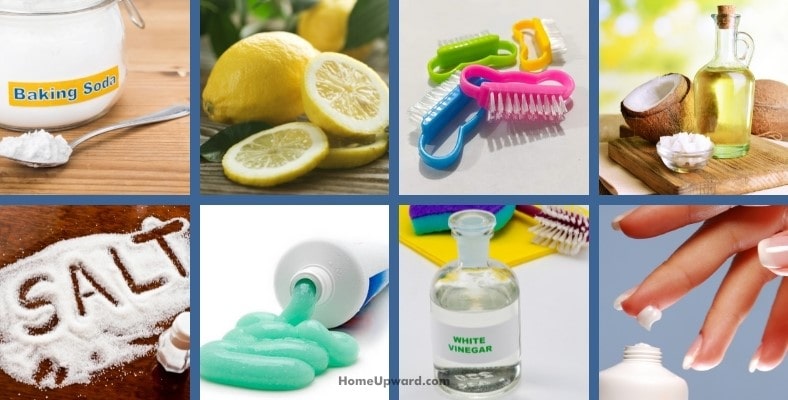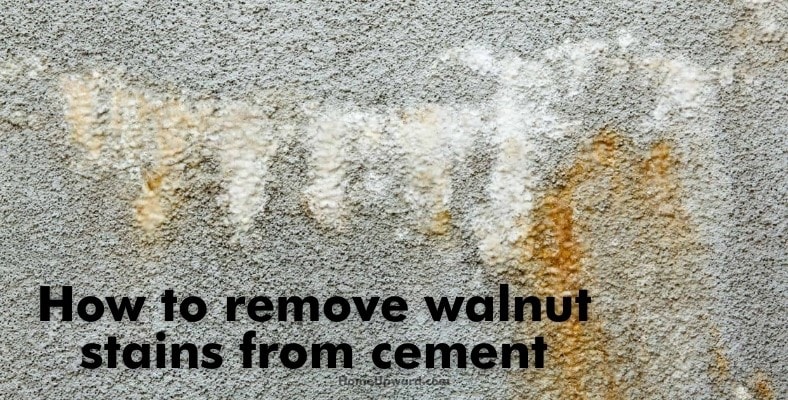Walnut trees belong to the Juglandaceae family. They are native to the Americas, southern Europe, Asia, and the West Indies. Walnut fruits are produced towards the end of the summer and the beginning of autumn.
The shell of walnuts contains a sap, which is what causes the staining. This can range from yellow to black in color depending on the age of the fruit and the variety of walnut tree.
Contents
How to prevent walnut stains
I strongly recommend wearing gloves while you handle walnuts, particularly black walnuts. This will stop the stain from spreading onto your skin and controlling the surfaces they come in contact with.
If you use disposable gloves, the clean up process is incredibly simple. If you are reusing your gloves, I advise washing them well with warm soapy water afterwards.
I also advise wearing protective goggles when you are stripping off the external shell of the walnuts (the epicarp). This is the tough and green outer coating of the walnut fruit.
If any walnut juice touches other surfaces, you should wipe it up as soon as possible using paper towels.
When attempting to get the nut meat out of the walnut shells, I recommend placing them in a bag. You can then hit this with a hammer to crack the shells without making a mess.
What makes walnuts stain?
There is a toxic chemical compound produced by black walnuts, known as juglone. This is so strong that it has been known to kill off foliage growth surrounding the walnut trees.
It can also cause health issues in horses following exposure to shavings. This compound can also have health impacts upon humans.
Juglone acts as an irritant to human skin. The chemical binds to the outer layers of skin, making it difficult to remove.
This chemical is almost black in color, and this is why walnuts stain. It is a similar pigment to that found in henna, another compound that can stain the skin.
As I metioned, it’s a skin irritant. It can make the whatever area it gets on sore, itchy, and to start having serious blisters. This is not only from the walnuts as woodworkers who deal with black walnut wood have been known to have the same issues.
How long do walnut stains last on skin?
As with henna, walnut stains are semi-permanent dyes and will naturally fade off over time. If you notice a black walnut stain, it is likely to take at least a month (30 days) to lift from your skin.
In severe cases, it can take up to 3 months to disappear completely. In cases like this, some layers of skin have also been known to peel off during the healing process.
How can you remove walnut stains? (7 great options)
There are many different home remedies that all claim to be able to lift walnut stains from your skin. They may not completely remove the entire stain, but the methods below are likely to reduce the stain’s potency.
Baking soda
- Make a thick paste with baking soda and water.
- Grab a clean toothbrush and use this to apply the paste liberally to the stained area of your hands.
- Rub the paste into your skin using a circular motion, and you should be able to see the stain beginning to lift.
Alternatively, you can substitute the water for dish soap. Use a ratio of 1 tablespoon baking soda to ¼ cup of mild dish soap.
Lemon
Before you start doing this, be aware that if you have any cuts on your hands or bite your nails, this may sting a little. If the skin on your hands is particularly dry, I don’t recommend doing it this way.
Instead, wash your hands thoroughly with soap and water to remove any loose debris from the walnuts then do the following:
- Juice a lemon into a small bowl, and use this juice to rub your hands.
- Keep rubbing the juice all over the stains, and you should begin to see them lift slightly. The citric acid contained within the lemon is known to have a lightening effect.
Nail brush
- You should first use the nail brush on dry hands to brush off any loose walnut debris.
- Continue to brush the stains on your dry hands until you begin to notice them fading.
- Wash your hands well with soap and water afterwards.
- If you have walnut stains underneath your nails, use the nail brush here while holding your fingers under running water.
Oil
Any kind of oil will work for this method.
- Grab the closest kind to you and pour a decent quantity into your hands. Rub this in well.
- You will need to do this 3 times to sufficiently lift the walnut stains.
This method can be used following the lemon juice method for the best results.
Salt
This method incorporates lemon juice too.
- Juice 2 lemons into a bowl and set aside.
- Tip a tablespoon of salt into the palm of each hand and pour the lemon juice over the top.
- Rub your hands together well to coat them in the salty scrub.
You should quickly begin to notice the stains lifting from your skin. The abrasion combined with the acid will be powerful enough to remove the stain without harming your skin.
Toothpaste
Toothpaste is formulated to protect your teeth from stains, so it makes sense that it would work on other stains too.
- Use a toothbrush to scrub the toothpaste in small circular motions into your skin.
- Keep doing this until the stain has lifted.
Vinegar
White vinegar is a staple household cleaning product. It has a huge variety of uses and one of these is as an effective stain remover.
You can fill a bowl with white vinegar and submerge the stained areas of your hands in here for up to 30 minutes. (Note: If you use this method you’ll need to thoroughly wash your hands afterwards.)
Alternatively:
- Pour some white vinegar onto a cotton pad or reusable cloth.
- Rub this over the stained areas of your hands until the stain begins to disappear.
Aftercare
All of these methods are likely to need to be repeated. Walnut stains can permeate pretty deeply into the skin and it can take up to 3 rounds of these methods to notice a real difference.
You should wash your hands well and liberally apply moisturizer after attempting any of these stain removal techniques. This is because many of these methods are abrasive and can cause surface damage to your skin.
Some cleaning solutions can draw moisture out of your skin so I recommend you rehydrate with moisturizer.
How can you remove walnut stains from clothes?
The first thing that you should do when walnut sap touches your clothes is to rinse them well in cold water. Next:
- Grab a mild dish soap and pour some liberally over the stained area of the fabric.
- Top this off with 4 drops of white vinegar. Rub these substances into the fabric of your clothing and place a piece of kitchen towel on the top.
- Allow this to sit, undisturbed, for up to 10 minutes.
- Rinse the stained area well under running water before throwing the clothes in the washing machine.
You can also use hydrogen peroxide to lift walnut stains from clothing. Here’s how:
- Apply the chemical liberally to the stained area of the clothes and allow it to wait here for up to an hour.
- Check on it every so often to ensure the fabric is not becoming damaged.
If you have any laundry detergent with bleach or bleaching additives this can be used too:
- Make a thick paste with equal amounts of detergent and water and apply this directly onto the walnut stain.
- Let it sit on the fabric for 10 to 15 minutes.
- Make a solution of white vinegar and warm water in a bowl and soak a clean cloth in this.
- Use this cloth to wipe the detergent paste off of your clothing.
- Finally, rinse it well under running water.
How to remove walnut stains from cement
If you have a path near to your walnut tree this is likely to become stained when they fall during certain times of the year as well as anytime the tree has nuts present.
Here’s how to remove walnut stains on your cement or concrete areas:
- Use a garden hose to wet the stained cement.
- Sprinkle over a powdered form of chlorine and then mist with a fine layer of water. Leave it to sit here for 5 minutes.
- While this is working, combine ⅓ cup liquid dish soap and ⅔ cup borax with a gallon of water. Mix well to combine.
- Grab a stiff-bristled brush and use this to scrub at the stains with the cleaning solution you have made. Scrub vigorously for at least 2 minutes and then rinse well with fresh water.







